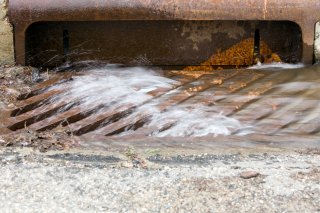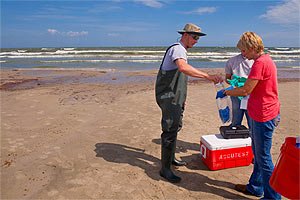What Can I Do to Protect Beaches?
Even if you do not live near a beach, you can still protect the water quality of beaches by preventing pollution from contaminating nearby waters that eventually travel to a beach. How can you make a difference?
- Keep septic systems properly maintained.
- Dispose of trash, as well as pet and other waste properly.
- Minimize the use of fertilizers.
- Prevent stormwater from flowing off your property.
- Participate in local monitoring and cleanup activities to learn how pollution in your local stream. or watershed affects water quality at downstream beaches.
- Engage in local municipal planning processes.
Maintain Your Septic System
If you have a septic system for your home and you live in a coastal area or close to water, regular maintenance of your septic system is very important to protect water resources. Septic systems at your home can contribute both bacteria and nutrient pollution to groundwater, rivers, or streams which may then end up polluting beaches.
Proper septic system maintenance includes periodic inspections and pumping as needed.
Reduce Trash
Did you know that no matter where your home or school is located, your trash could end up in the ocean? This is often the end result of poorly managed waste. Reduce your environmental footprint by decreasing the amount of waste you create and increasing the amount of waste you recycle. By adopting small changes at home, you can help prevent marine debris at its source.
Learn more about the EPA's Trash-Free Waters program, which is reducing the volume of trash entering U.S. waterways.
Keep Pollution Out of Storm Drains

Storm drains are not trash bins! Storm drains usually carry water that flows directly to rivers, streams, wetlands or the ocean, so things like motor oil, paint, yard waste, or trash should never be put down a storm drain. Used motor oils can be recycled at your local service shop or other locations. Other household materials, such as paint, are often collected at hazardous material collection events in your community.
Earth 911 provides information on the locations where you can recycle certain materials.
Use Lawn Care Products Properly

Fertilizers, pesticides, and other lawn care products can wash off lawns, onto streets, and out to beaches by waterways or stormwater drainage systems. You can prevent pollution from fertilizers and pesticides by following the recommended application rates, minimizing your use of these products, and using native grass species.
Apply fertilizers only when your lawn is growing. This will increase the amount that is absorbed by the grass and decrease the amount that washes into waterways.
Homeowners who live near a pond, lake or stream should select a phosphorus-free fertilizer because too much phosphorus in the water can promote algae growth.
You should also prevent fertilizer from running off into sewers. After fertilizing, sweep any stray fertilizer on driveways, patios and sidewalks back on to your lawn where it can do its job.
Use proper landscaping techniques to help reduce the flow of water and nutrients from your lawn into local waterways and storm drains.
Adopt Green Infrastructure Practices

Green infrastructure uses vegetation, soils, and natural processes to capture stormwater and reduce the amount of runoff that enters streams, rivers, water bodies, and coastal waters.
When adopted throughout a community, green infrastructure can help reduce the amount of stormwater that enters the sewer system which can contribute to sewer overflows during heavy rainfall.
Your home is an easy place to support different types of green infrastructure. Steps you can take include:
- Disconnecting a downspout
- Collecting rainwater
- Creating a rain garden
Participate in Cleanups and Water Quality Monitoring

Participate in a beach, river, or stream cleanup or monitoring event in your area and make a difference! By removing trash and other debris from around your local waterway, you are helping to keep your water clean and safe from pollution! Contact your state or local Parks and Recreation Department or environmental organizations for information about clean-ups in your area. If you can't find a cleanup in your area, try organizing your own!
You can also become a volunteer water quality monitor. Volunteers analyze water samples for different measures of water health at and upstream of beaches, catalog and collect beach debris, and restore degraded habitats.

- The Volunteer Monitoring Network helps share resources among volunteer monitoring programs. It also serves as a location to help those seeking work in water-related positions (e.g., volunteer monitoring, citizen science, and outreach) find organizations that have open positions.
- Find manuals and other resources for performing water quality monitoring.
Engage in Beach Protection Policies
Engage in your local municipal planning processes and take a role in protecting beaches.
- Green Infrastructure is an approach for reducing stormwater runoff in your community. Green infrastructure soaks up rainfall which carries pollution from streets, parking lots, rooftops, and yards. Some communities may also encourage home businesses and owners to voluntarily adopt green infrastructure practices.
- Septic System Setbacks and Technology - Your community may have policies that require setbacks for septic systems from water resources. These setbacks may apply to septic systems close to coastal waters or tributaries. Setbacks are designed to increase the distance between septic systems and coastal waters to prevent bacteria, nutrients, and other pollution from entering coastal waters and beaches. Communities may require property owners to install alternative septic systems to achieve higher levels of treatment in coastal areas, or increase the level of management required for septic systems.
- Adaptation to Sea Level Rise - Development on or near sensitive beach habitats such as sand dunes can inhibit the ability of beaches and shorelines to adapt to climate change. Beaches and their dune systems migrate inland in response to sea level rise. In developed areas, governments and landowners have usually attempted to hold back the sea by adding sand to eroding beaches or erecting dikes, seawalls, revetments, and other shore protection structures. These practices prevent beaches from migrating inland with rising sea levels, and could result in beaches disappearing under sea water.
- Rolling easements (pdf) - These are a series of non-regulatory approaches for ensuring that wetlands and beaches can migrate inland, as people remove buildings, roads, and other structures from land as it becomes submerged.
